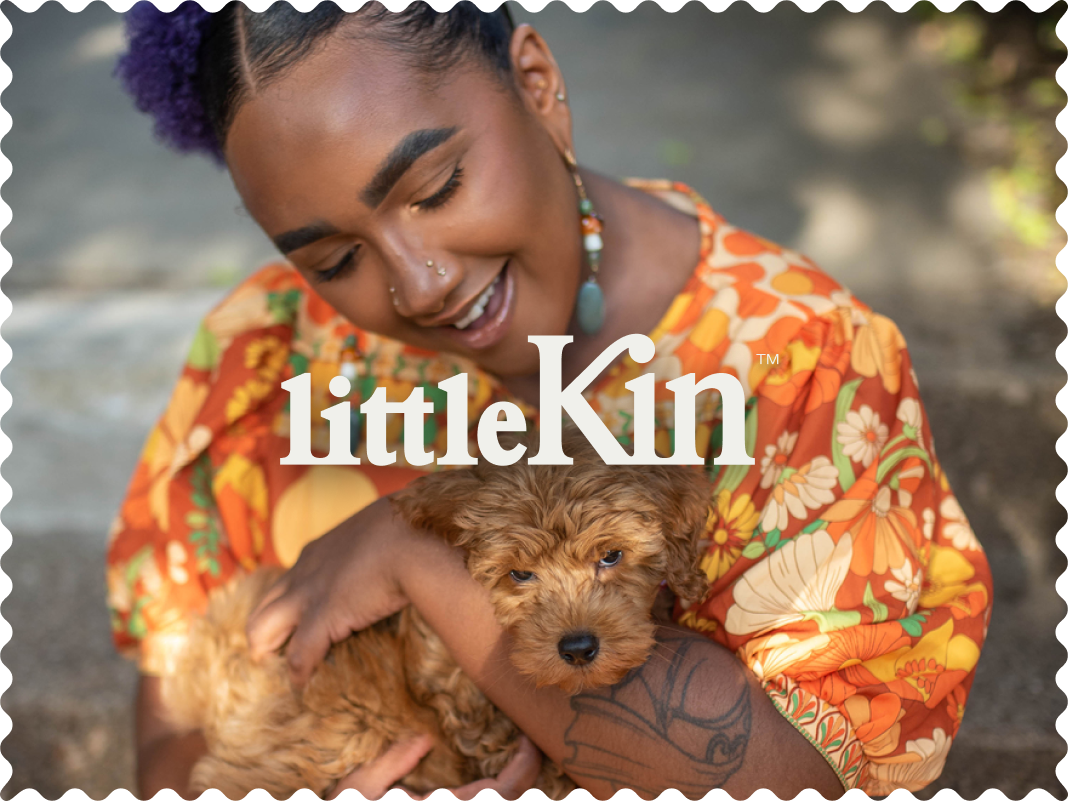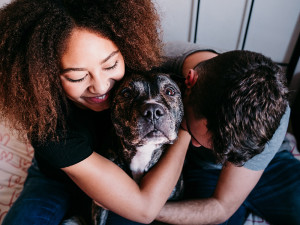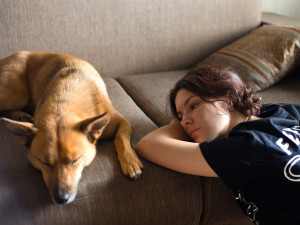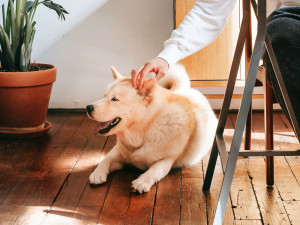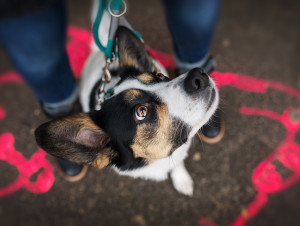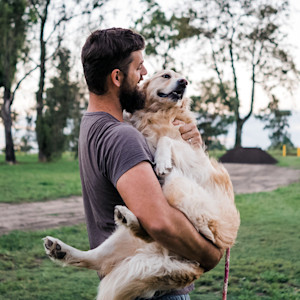How Dogs Really Choose Their Favorite Human (It’s Not Just About the Treats)
Pups definitely have their ‘person.’
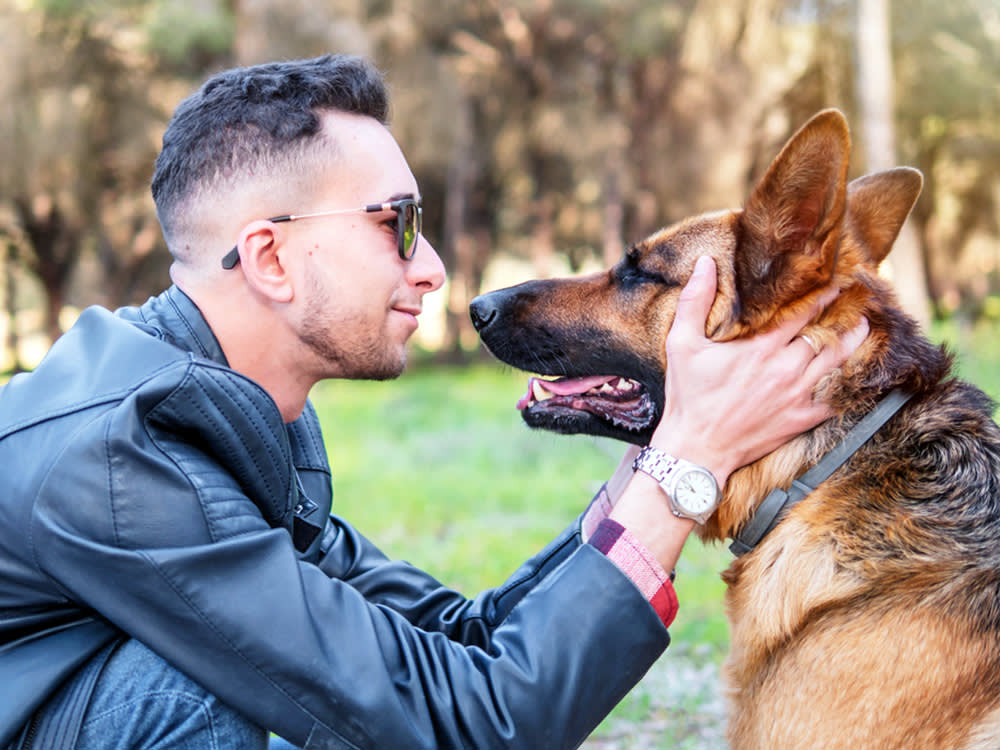
Share Article
When we bring a new dog into the house, many of us do so with a specific fantasy. We want to be this new critter’s best friend. Their closest confidant. Their favorite snuggle buddy. To put it in Grey’s Anatomy terms, we want to be the Cristina Yang to their Meredith Grey — their person. But this can become a problem when there are multiple humans in the house.
There can only be one favorite, and sometimes, a dog’s choice can hurt their human family members’ feelings. The family member who tries too hard might feel slighted when the person who doesn’t even like dogs somehow winds up with a furry shadow always on their heels. But is any of this real, or are we all just projecting way too much onto our animals (as usual)? Do dogs really play favorites? And more importantly, if they do, is there any way to tip the scales in our favor?
All three experts who spoke with me for this article agree that yes, our dogs definitely tend to claim a person in their household — and that once they’ve made their choice, it’s unlikely to change. Still, the selection process might not be what you think. Read on to learn more about how our dogs pick their human BFFs, and how to strengthen your bond even if you’re not The One.
How do dogs choose their person?
As with so many things, this can depend on the dog. But generally speaking, doggy favoritism follows a few patterns. They tend to choose the person who spends the most time with them, rewards them in ways that they like, and best speaks their language — whatever that might be.

Maddie Messina, an associate certified applied animal behaviorist and founder of Paws for Thought Dog Trainingopens in new tab, says that dogs tend to choose their person based on “learning history” — meaning, “the person they’ve learned provides the most resources.” That could be anything from food, to playtime, to attention and affection. Different dogs will value all of those assets differently. “While some may value food,” Messina says, “others may value play more. In that case, even if ‘mom’ is giving the most meals, if ‘dad’ is taking the dog out for the most fetch, ‘dad’ might then be the person.”
Professional dog trainer Debora Nicholsopens in new tab breaks dogs’ reasoning into three categories. Dogs might choose their favorite human based on:
Quality time
Positive reinforcement (play, attention, food, toys, etc.)
Past experience
That last bullet point applies especially to newly adopted dogs. “I find if they are rehomed, and their previous owner [or] human was male, they tend to bond quicker to another male,” Nichols says.
Why does my dog favor the person who isn’t into dogs?
Unfortunately for us try-hards, dogs don’t usually love it when we do too much too fast. In fact, Jessica Lockhart, Ph.D, certified behaviorist and founder of Fairview Behavior Associatesopens in new tab, has found that oftentimes, the person in the house who didn’t even want a dog is the one they love the most.
“A lot of that has to do with our body language as humans,” Lockhart says. “If there’s something we don’t like, we tend not to look at it. We tend to just kind of ignore it, really give it the cold shoulder. And for dogs, that’s super friendly.”
Dogs often use appeasement behaviors like avoiding eye contact or angling their bodies away from each other (and humans) to signal that they’re not a threat. That’s why so many dogs love people who aren’t all over them the second they come home. This can be a valuable lesson for those of us who desperately yearn for dogs’ approval.
“When you go to meet a dog, you want to avoid eye contact,” Lockhart says. “You don’t want to approach directly. You want to take your time. Typically, the person who’s the most avoidant is giving the really nice, positive doggie language.”
For the record, the same is apparently true for cats.
Do dogs like certain types of people better?
As someone who’s witnessed a fair number of dogs getting growly at men in particular, I had to wonder if certain demographics tend to be more popular among the canine contingent than others. The answer is “yes,” but once again, which groups often depends on the individual dog.
Lockhart confirms that dogs are often more hesitant around men than women, which can stem from each gender’s physical build. Messina and Nichols also agree that tone of voice can play a factor: a 2023 studyopens in new tab used brain scans to show that dogs responded more to dog- and infant-directed speech, especially from women.
Age can inform dogs’ preferences as well. According to Nichols, kids seem to connect better with younger dogs and puppies. “I think the playfulness of a child is more attractive,” he says, “because play is one of the things dogs find reinforcing.” Still, even the most playful of pups can have their limits. Lockhart says that toddlers tend to be “red flags” for dogs “because they move weird. They sound weird. And usually, they're a little bit sticky.” Anecdotally, she adds, lower-energy dogs might gravitate toward lower-key people — even sullen teenagers who like to be left alone in their rooms.
Some of your dog’s preferences might come down to early-life socialization, too. Dogs who have not been exposed to people with certain builds, or in certain clothing, might become hesitant when they encounter them for the first time. According to Lockhart, this should not be taken as judgment; dogs just get skittish around the unfamiliar. Don’t we all?
Can dogs change favorites?
Generally, if your dog has chosen their “person,” that special status will stick for life. Still, there can be exceptions. “I would think, for example, if ‘mom’ [previously worked from home] and then switched with ‘dad’ to being in office, that relationship with the dog might change based on access,” Messina says.
How can I tell if I’m my dog’s person?
If you’re your dog’s favorite, it’s usually pretty obvious. According to Nichols, they’ll usually follow you around more and might even try to sleep closer to you. There’s also the age-old test seen in countless movies and TV shows: If you want to see who your dog’s favorite is, you can walk in different directions and see who they follow.
“I would bet that they go with their favorite human 100 percent of the time,” Nichols says.
All of that said, Messina notes that the family member a dog “listens” to the best is not necessarily the favorite. “For example,” she says, “if a dog has learned that person punishes them swiftly when they don't respond, the dog will probably learn to attend quickly to that person to avoid punishment.”
When playing favorites gets dangerous
Most of the time, figuring out who the family dogs likes most is a fun little game we humans play. But just like with human relationships, certain attachments can also turn toxic. Watch for red flags like your dog refusing to give space to anyone who comes near you — especially family members. Sometimes, Lockhart says, that can turn into territorial behavior or even aggression.
“I've had couples who can't sleep in the same room,” Lockhart says. “I've had couples who can't touch in front of the dog. They can’t even give each other a hug, because the dog will become very territorial.”
If you start to notice your dog getting insecure, Lockhart recommends strengthening the non-favorite’s relationship with the dog. For starters, they can “make treats rain from the sky” when they walk into the room. “You're going to ignore the dog,” Lockhart explains, “but accidentally, treats fall out of your pocket when you walk by. Then, you just keep going. We don't make eye contact, we don’t reach for them, we don't call their name.” The more aloof the non-favorite can be, the better. Let the dog set the tone.
Apart from making sure your dog knows the non-favorite person is safe, too, it’s important to make sure that the non-favorite does not disrupt your pooch’s quality time with their chosen human.
“If dog is sitting on the favorite, and every time you come over, they get pushed away, they might start thinking you are trying to come between them,” Lockhart says. Instead of shooing the dog, you can have them switch sides to share the space. Over time, you can increase that space incrementally. “Again,” Lockhart says, “you want to avoid a situation where the dog's losing their favorite person just because someone else came over.”
Just like with humans, the key to healthy relationships always comes back to boundaries.
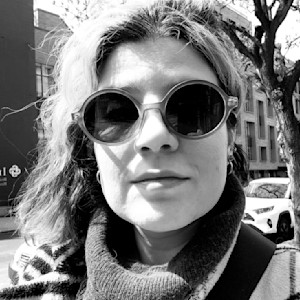
Laura Bradley
Laura is a New York-based experienced writer and mom of two rescue pups. Her work has appeared in Slate, Vanity Fair, Daily Beast, The Washington Post, The Atlantic, Yahoo! News, Vulture, Grazia Magazine, and more. When she is not writing or walking the pooches, you will probably find her in the community garden.
Related articles
![Couple hugs their merle Boxer]()
How to Improve Your Relationship with Your Dog
Animal behaviorist Dr. Karen B. London on how to strengthen your pet-parent bond.
Does My Dog Love Me? How to Interpret Canine Bonding Behavior
What to do when you don’t feel the close bond you want.
![Unrecognizable man sitting at desk petting his dog]()
How to Pet a Dog — Yes, You Do Need Lessons
There’s a difference between being affectionate and being annoying.
![Dog on leash sitting on a colorful street and looking attentive at their pet parent]()
How to Get Your Dog to Pay Attention to You
Here are some simple steps to pry your pup away from that one spot in the yard they’re obsessed with.
![Man holds his Labrador dog in his arms outside.]()
You Raise Your Dog the Way Your Parents Raised You, New Study Finds
One more thing to talk about with your therapist.
